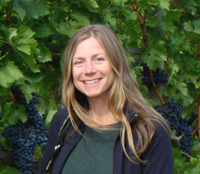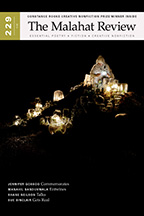The Character as Attribute:
Samantha Ainsworth in Conversation
with Pauline Holdstock

Malahat volunteer Samantha Ainsworth talks with Pauline Holdstock, one of three judges for our upcoming 2014 Novella Prize.
Your latest novel, Into the Heart of the Country (long-listed for the 2012 Giller Prize) focuses on the integral role and sacrifices of native women during the 18th-century Canadian fur trade. You have created a vehicle through which these essential women are brought into our midst, into our world of iPads, microwaves, and fast food. How did you come to unearth these vital women, and their stories buried with them? And what drove you tell their tale?
Every period of history has its official, received account, a version riding over top of the untold stories that you find if you rake around in in history’s footnotes. For me the footnotes and the margins also merit attention, and can be used to highlight neglected episodes of the received version. In Samuel Hearne’s letters, I found a sentence that kindled some of the ideas I was playing with. When he returned to Prince of Wales Fort after surrendering it to the French, he wrote, “…all the Indians that used to trade here are either dead with the small pox, starved to death last winter or removed so far into the heart of the country that it will be next summer at least before the few survivors hear of my arrival here.”
It was that untold journey “into the heart of the country” that I wanted to bring to life on the page. I chose the historical figure of Mary Norton – my Molly—to carry it, because I’m always most fascinated by what I think of as the secondary cast, the “bit players” even, in the official historical record. It’s a way of giving voice to those who were allowed no chance to tell their own stories—and without a doubt, the role of women in the fur trade was central.
As a thorough researcher and historical fiction writer, do you ever feel that you are summoning ghosts and drawing from them in order to forge your fictional characters?
Oh, you can get arried away with that line of thinking! There are times, certainly, when something I think I’ve dreamed up has had, as I discover only later, an eerie correspondance with life. An example of this is the image that came to me of Nêwositêkâpaw—a female character based on a historical figure—dropping to her hands and knees at the limit of her journey. When I later enquired about the meaning of her Cree name, I was told the English translation was “Goes on all fours.” And Molly’s passages certainly seemed effortless to write. But this is, I think, evidence of the underestimated power of the imagination. There is so much that we absorb unconsciously in our lives—seeds of knowledge, stories, myth, wisdom—from all kinds of sources. It’s the imagination that synthesizes and gives voice to it all.
Your novel, Beyond Measure,was a finalist for the 2004 Giller Prize. You speak of this book and read a delightfully gruesome excerpt in a 2004 audio interview with Bill Richardson, talking about the “visitation of a book idea,” and the way it can descend on you in the same manner as the conception of a poem. Can you speak to this, your initial attraction to a subject?
It’s not that I ever start out with an attraction. The initial attraction really is in the opposite direction. The subject seems to arrive, to wing its way in out of the blue and somehow attach itself. And it’s always vague—an emotion, a sense of an emotion, a colour, an image of some kind, but perhaps not yet visual. For “Beyond Measure,” it was a sense beauty, of many colours, and terror too. For my novella, “The World of Light where We Live,” it was a sense of great love, great self-sacrifice, something maternal. For “Into the Heart of the Country,” it was an image of vastness, something to do with being alone and great extremity.
When you look at them, these ideas or images are pretty unfledged. So the novel writing becomes the means to fledge these ideas, give the form, allow them take flight—you hope! It’s a mysterious process and it demands a good deal of faith that they will eventually assume a narrative form. But the uncertainty is what keeps it all interesting. Otherwise, it would be painting by numbers.
You utilize such skillful poetic devices in your works of fiction and even in your essays. Have you written or published any poetry?
I’ve published a very small amount in literary journals. I’m a poet at heart, but I’ve never quite recovered from showing my first poem to a high school teacher in England and being told that it didn’t scan. Whatever poetry I possess is channelled into my fiction. But it’s an interesting question. I’m just in the process of discovering that that poetic impulse is actually central to my writing process. It works at a level deeper than technical use of language. It’s a way of receiving―and conveying―the world. And this relates of course to your previous question about how novels arrive. In images!
It is in fact only this year that I’ve discovered, thanks to John Metcalf, what it is I really do. In an essay in The New Quarterly, Metcalf discusses Imagism. It hadn’t occurred to me that I’m using the techniques of the Imagists in prose. It hadn’t occurred to me—even as I was using them-- that you could use those techniques.
I recently had the pleasure of reading your novella, The World of Light Where We Live, winner of The Malahat Review’s 2006 Novella Contest. The pressure you placed on your characters was immense, unrelenting. I haven’t clung so tightly to a manuscript in years. You masterfully switched points of view from one character to another, never allowing the storm to let up. As a writer, what were the challenges, and would you encourage new writers to attempt this technique?
I think the pressure the reader feels is directly related to the pressure the writer felt! I had decided that year to take up challenge of National Novel Writing Month (NaNoWriMo) during November and announced as much to to my family. It meant undertaking to write about a thousand words a day. It happened to suit my purposes very well, because the story is one of great urgency. My character is in a state of extremity. She’s working against both time and the weather―and time is running out. So it became a new take on form and content.
And yes, I’d highly recommend this exercise. It imposes a severe constraint on the work, and constraint is a powerful tool. When you’re working―as a poet does!―within any kind of constraint, amazing things begin to happen, to bloom from the unconscious mind because there is no room for your conscious, your editing mind to come in and start running the show. Harry Matthews described this process very clearly in an essay for Brick.
Many of the protagonists in your stories are women whose potentials are stymied by status and circumstance. As a writer, there must be a great sense of satisfaction in helping your characters overcome these challenges. Is this change well established in your mind before you set to writing, or do you allow the characters to discover their strengths and abilities as the stories develop?
This is a question I have trouble relating to because I don’t consider that I write novels of character. For me, characters represent qualities or attributes—resilience, fortitude, liberty, vigour, love, greed and so on. That they end up “coming alive” on the page or changing and developing is for me almost irrelevant. It’s the work that these qualities effect in the world that interests me.
The novella is an interesting genre. There isn’t room to ramble within its constraints of economy. Do you think perfection might be more attainable with a novella than with a novel?
I do. And there are certain novellas I consider perfect. Anne Hébert’s A Suit of Light is one. Also her Aurélien, Clara, Mademoiselle, and the English Lieutenant, whose uneconomical title is like a delighful inside joke. Flaubert’s A Simple Heart is another. A more recent example would be Justin Torres’ We the Animals. I think it’s marketed as a novel, but its length and its shape make it a perfect novella. It has that incredible sense of drive, and though it’s exploding with vigour, it has an incredible concision and single-mindedness. The greater the constraint, the greater the chance of perfection. No doubt it’s why Haiku seems so often to succeed.
As a past winner, and a judge for the Malahat’s 2014 Novella Prize, is there any advice you offer writers about the challenges involved in the novella form?
Keep the camera trained on your subject; never let go, not for a second.

Samantha Ainsworth
* * * * * * * *
Read full guidelines for our 2014 Novella Prize.









